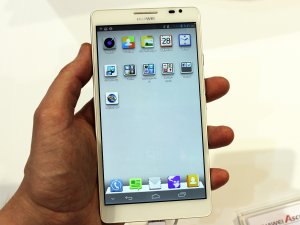Huawei is a relatively unpopular brand in the Smartphone and tablet markets. The company has concentrated on manufacturing devices for resale by other companies, before coming out with their own devices carrying the company name. It didn’t help that most of these devices were inexpensive and cheaply built. In 2013, Huawei released the Ascend Mate, a Smartphone-tablet hybrid that attempts to rival the Samsung Galaxy Note and Note II. The company claims that the device is “superior” to its competition.

Design
The Ascend Mate was built as a cross between a Smartphone and a tablet. At 163.5 x 85.7 x 9.9 mm and 198 g, it is definitely bulkier than most Smartphones and is difficult to manage with only one hand. The glossy plastic rear is curved to fit better in the palm, but without a grip or any sort of textured surface (and due to its size!), it will be hard to try and not drop this.
Performance
The Huawei Ascend Mate is powered by a quad-core 1.5 GHz processor and a Huawei K3V2 chipset. It has 2 GB of RAM and up to 32 GB external memory. The device runs on the latest version of the Android Jelly Bean operating software. It uses a Li-ion 4050 mAh battery that lasts up to 216 hours on stand-by. It comes in crystal black and pure white.
Connectivity
As a communication device, the Ascend Mate has all the connectivity features that a user will need such as the standard GSM and HSDPA. Data transfers are also made possible via GPRS, EDGE, HSUPA and dual-band WiFi and WiFi Direct. Whether or not you are going to make Internet calls through free VoIP software or from subscriptions to companies such as RingCentral, the Ascend Mate will help users have a smooth communication.
Display
The huge 6.1-inch IPS + LCD capacitive touchscreen is made of multitouch Corning Gorilla Glass and runs on the Emotion user interface. With 16 million colors and 720 x 1280 pixels, it falls short of other Smartphone screens. A 241 ppi pixel density just doesn’t make sense on a larger screen, particularly when smaller Smartphones have significantly higher res displays. Colors are not as vivid and pixels are quite visible.
Camera
The Ascend Mate has an 8 megapixel primary camera (up to 3264 x 2448 pixels) with autofocus and LED flash. Camera capabilities include geo-tagging, face detection, panorama mode, and HDR video mode. Balancing the phone while taking a picture is a little tricky. You’ll need two hands to press the shutter button. In front is a 1 megapixel secondary camera – unimpressive, but good enough for taking self-portraits. You can change the camera effects and scene modes through the camera app, which has fewer options than most Smartphones.
The Huawei Ascend Mate tries to blur the line between Smartphone and the tablet. Who needs both when you can have them in one gadget? It’s difficult to gauge if consumers will go for this “phablet” gimmick. In fact, in 2013, some Smartphone manufacturers are actually trying to make their devices more compact. A 6.1-inch phone totally misses the mark. There’s the Sony Xperia ZL, for one, which is only 5 inches long. A lot of Smartphone users have by now gotten weary of bulky devices and are going for smaller ones. In this mindset, there’s a role for a compact Smartphone to stash in the pocket and take everywhere and a separate role for a tablet to keep at home or at the office.


























Leave a Reply